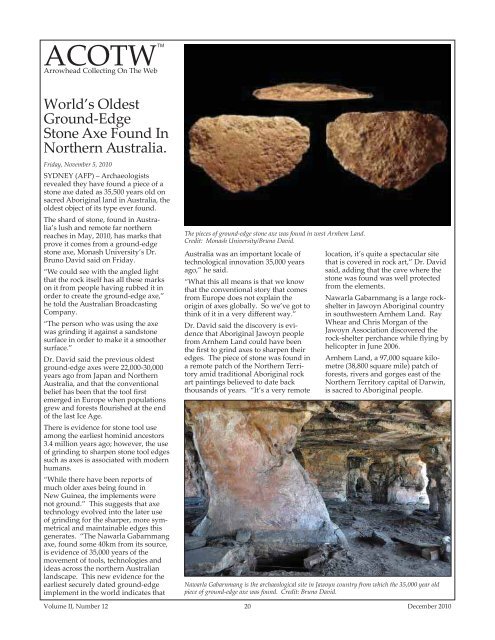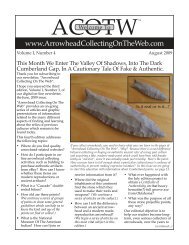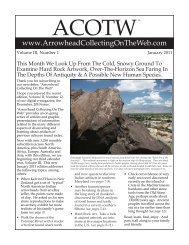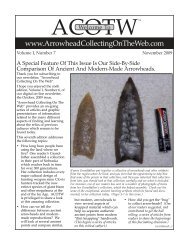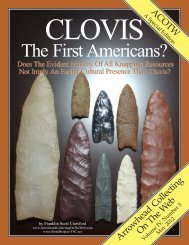Rock, Paper, Scissors - Arrowhead Collecting On The Web
Rock, Paper, Scissors - Arrowhead Collecting On The Web
Rock, Paper, Scissors - Arrowhead Collecting On The Web
You also want an ePaper? Increase the reach of your titles
YUMPU automatically turns print PDFs into web optimized ePapers that Google loves.
ACOTW<br />
TM<br />
<strong>Arrowhead</strong> <strong>Collecting</strong> <strong>On</strong> <strong>The</strong> <strong>Web</strong><br />
World’s Oldest<br />
Ground-Edge<br />
Stone Axe Found In<br />
Northern Australia.<br />
Friday, November 5, 2010<br />
SYDNEY (AFP) – Archaeologists<br />
revealed they have found a piece of a<br />
stone axe dated as 35,500 years old on<br />
sacred Aboriginal land in Australia, the<br />
oldest object of its type ever found.<br />
<strong>The</strong> shard of stone, found in Australia’s<br />
lush and remote far northern<br />
reaches in May, 2010, has marks that<br />
prove it comes from a ground-edge<br />
stone axe, Monash University’s Dr.<br />
Bruno David said on Friday.<br />
“We could see with the angled light<br />
that the rock itself has all these marks<br />
on it from people having rubbed it in<br />
order to create the ground-edge axe,”<br />
he told the Australian Broadcasting<br />
Company.<br />
“<strong>The</strong> person who was using the axe<br />
was grinding it against a sandstone<br />
surface in order to make it a smoother<br />
surface.”<br />
Dr. David said the previous oldest<br />
ground-edge axes were 22,000-30,000<br />
years ago from Japan and Northern<br />
Australia, and that the conventional<br />
belief has been that the tool fi rst<br />
emerged in Europe when populations<br />
grew and forests fl ourished at the end<br />
of the last Ice Age.<br />
<strong>The</strong>re is evidence for stone tool use<br />
among the earliest hominid ancestors<br />
3.4 million years ago; however, the use<br />
of grinding to sharpen stone tool edges<br />
such as axes is associated with modern<br />
humans.<br />
“While there have been reports of<br />
much older axes being found in<br />
New Guinea, the implements were<br />
not ground.” This suggests that axe<br />
technology evolved into the later use<br />
of grinding for the sharper, more symmetrical<br />
and maintainable edges this<br />
generates. “<strong>The</strong> Nawarla Gabarnmang<br />
axe, found some 40km from its source,<br />
is evidence of 35,000 years of the<br />
movement of tools, technologies and<br />
ideas across the northern Australian<br />
landscape. This new evidence for the<br />
earliest securely dated ground-edge<br />
implement in the world indicates that<br />
<strong>The</strong> pieces of ground-edge stone axe was found in west Arnhem Land.<br />
Credit: Monash University/Bruno David.<br />
Australia was an important locale of<br />
technological innovation 35,000 years<br />
ago,” he said.<br />
“What this all means is that we know<br />
that the conventional story that comes<br />
from Europe does not explain the<br />
origin of axes globally. So we’ve got to<br />
think of it in a very diff erent way.”<br />
Dr. David said the discovery is evidence<br />
that Aboriginal Jawoyn people<br />
from Arnhem Land could have been<br />
the fi rst to grind axes to sharpen their<br />
edges. <strong>The</strong> piece of stone was found in<br />
a remote patch of the Northern Territory<br />
amid traditional Aboriginal rock<br />
art paintings believed to date back<br />
thousands of years. “It’s a very remote<br />
location, it’s quite a spectacular site<br />
that is covered in rock art,” Dr. David<br />
said, adding that the cave where the<br />
stone was found was well protected<br />
from the elements.<br />
Nawarla Gabarnmang is a large rockshelter<br />
in Jawoyn Aboriginal country<br />
in southwestern Arnhem Land. Ray<br />
Whear and Chris Morgan of the<br />
Jawoyn Association discovered the<br />
rock-shelter perchance while fl ying by<br />
helicopter in June 2006.<br />
Arnhem Land, a 97,000 square kilometre<br />
(38,800 square mile) patch of<br />
forests, rivers and gorges east of the<br />
Northern Territory capital of Darwin,<br />
is sacred to Aboriginal people.<br />
Nawarla Gabarnmang is the archaeological site in Jawoyn country from which the 35,000 year old<br />
piece of ground-edge axe was found. Credit: Bruno David.<br />
Volume II, Number 12 20<br />
December 2010


